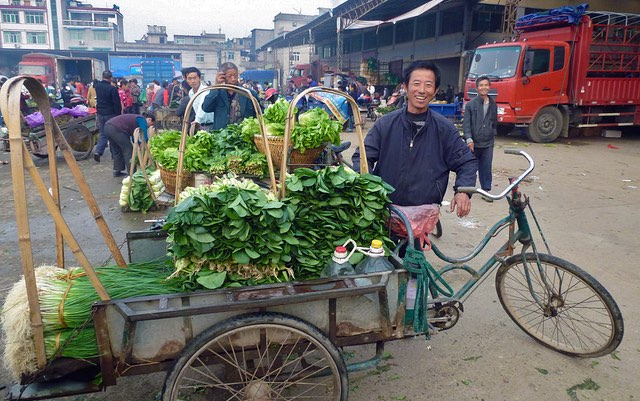Despite China’s impressive progress in reducing poverty, hunger, and nutrition over the past four decades, challenges remain, especially in rural areas. More than 3 percent of rural residents live under the poverty line ($1.9 a day), while 12 percent of rural children under five are stunted. Stunting has far-reaching ramifications, affecting children’s cognitive and physical development and decreasing their productivity. “To revitalize agriculture and rural areas in China, we must start investing in nourishing rural children,” IFPRI Director General Shenggen Fan said during the Rural Vitalization and Modernization session at the China Development Forum in Beijing on March 24.
The rural revitalization strategy has been at the top of the Chinese government’s agenda since the 19th CPC National Congress in October 2017. The strategy aims to address urban-rural disparities and modernize the rural economy by improving infrastructure, supporting innovations in science and technology, advancing supply-side structural reform in agriculture, and deepening rural land ownership and subsidy system reforms.
Fan shared success stories, lessons and strategies from South Korea, Japan, Thailand, the European Union, and the United States, and proposed lessons for China as it advances its rural development plan.
The “Saemaul Undong” or New Village Movement brought dramatic changes to South Korea. Launched in 1970s, the initiative highlighted the importance of self-governance and cooperation in rural communities to modernize the economy, strengthen infrastructure, improve living conditions, and protect farmers’ rights.
Japan, in addition to investing in rural infrastructure, has promoted inclusive rural-urban linkages to connect local farmers to urban consumers through farmers’ markets and cooperatives. Rural populations in Japan are skewing older, as in China, as young people have migrated to urban areas. In 2000, Japan implemented a mandatory social long-term care insurance program providing elderly people in rural areas affordable home- and community-based services such as home help, adult day care, and visiting nurses.
In Thailand, developing niche products and empowering rural areas has been key to poverty reduction. The government’s “One Tambon One Product” (OTOP) program, which supports the production and marketing of items from Thailand’s 7,255 tambons, or sub-districts, has sparked local entrepreneurship and provided alternative incomes for poor farmers. Thailand has also promoted rural-based initiatives including organic rice farming, handicraft production, and rural tourism to increase local employment and sustainable livelihoods.
By converting agricultural subsidies to rural development support, the EU has linked payments to food safety, environmental protection, and sustainable agriculture. It has shifted production subsidies to income support and direct payments, and set up special funds to support rural areas. The new EU farm policy has also introduced better-targeted and more equitable safety nets that reward farmers for climate-smart and sustainable practices.
The U.S. recently unveiled a $1.5 trillion infrastructure investment plan, of which a substantial portion will be used to improve rural infrastructure, including transportation, hydropower, and broadband connectivity. New technologies and work modalities, such as e-commerce and telework, have also shown potential to revitalize rural areas, creating business and development opportunities as well as keeping rural towns connected.
“The United States has an intriguing development history,” Fan said. “At the beginning of the last century, agriculture and rural areas in the U.S. were prosperous. However, in the 1960s and 1970s, a large portion of the rural population moved into the cities. Recently, we see a new trend: people are leaving the cities. They live in places two or three hours away from the central city so that they can enjoy both the spacious living space as well as fresh air in the suburban or rural areas and have access to quality healthcare, entertainment options, and other amenities available in the cities. As China revives its rural areas, more people may leave the big cities for villages and small towns. Adoption of new technologies, work modalities, and efficient transportation system will build viable business and revitalize rural areas in China.”
Based on the successful experiences from other countries and his own observations of China’s agriculture and rural areas, Fan proposed key elements for the implementation of China’s rural revitalization strategy:
- Address environmental issues in wealthier rural areas, with an emphasis on behavior change, collective action, and education on environmental-health linkages.
- Fix the fundamentals in poorer rural areas, improving access to quality education, upgrading infrastructure, and facilitating migration.
- Empower and motivate rural villages and communities, promoting local, niche products for nutritious, healthy foods from rural areas.
- Reform subsidy policies, converting production subsidies to income support or to improve livelihoods and the environment.
- Strengthen rural-urban linkages, improving physical connections, value chains, and broadband connectivity.
- Integrate agriculture and rural development strategy, policy, and investment.
In March, China formed the new Ministry of Agriculture and Rural Affairs (previously Ministry of Agriculture). The new agency merges the duties of the Ministry of Agriculture and several other agencies to streamline the government and improve its efficiency in promoting rural development.
Fan congratulated the government on this institutional restructuring and urged corresponding improvements to be made at provincial and county levels. The integration of agriculture and rural affairs at all levels of government can provide a fundamental institutional basis to address issues related to agriculture, rural areas, and rural people.
Xinyuan Shang is an IFPRI Communications Specialist. The China Development Forum, organized by the China Development Research Center of the State Council, is the preeminent platform for dialogue between China’s senior leadership and representatives of leading global businesses, international organizations, and scholars. The theme of this year’s forum was “China in the New Era.”







